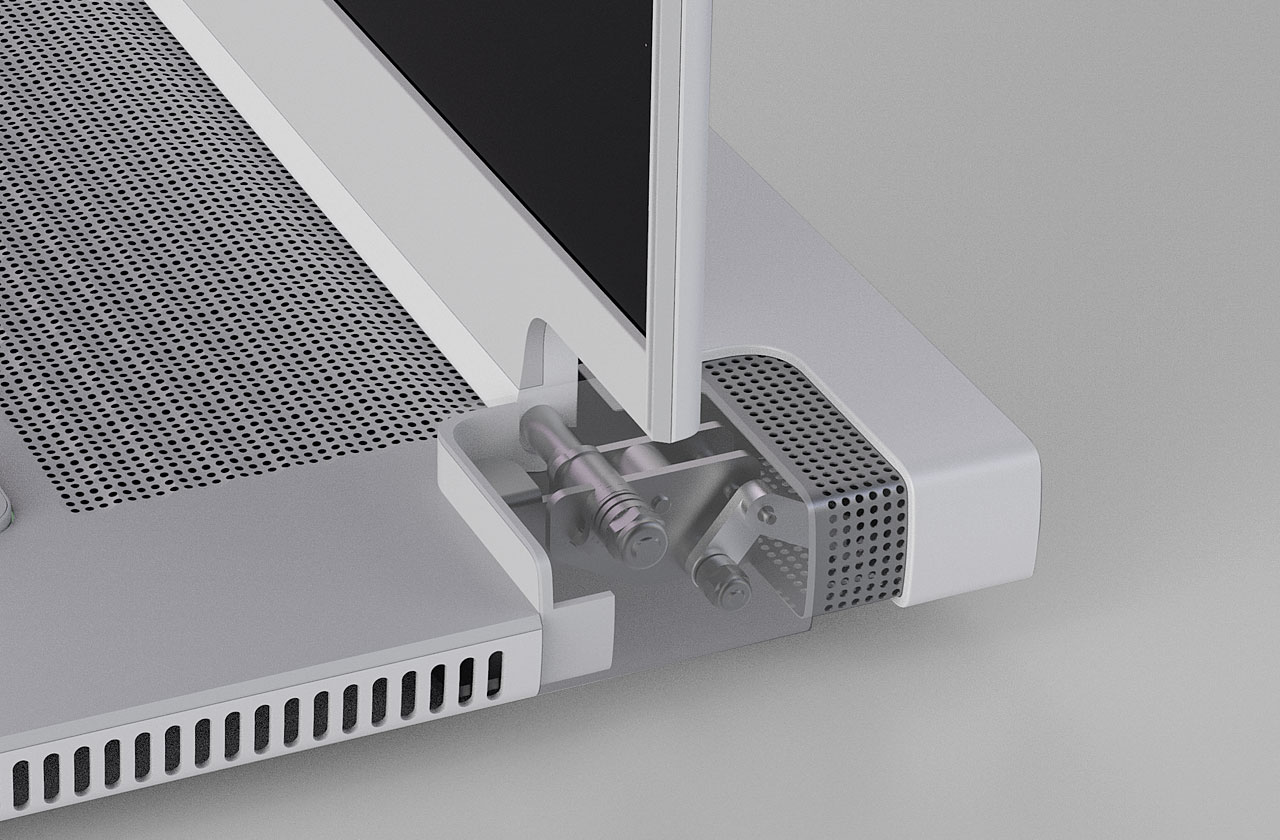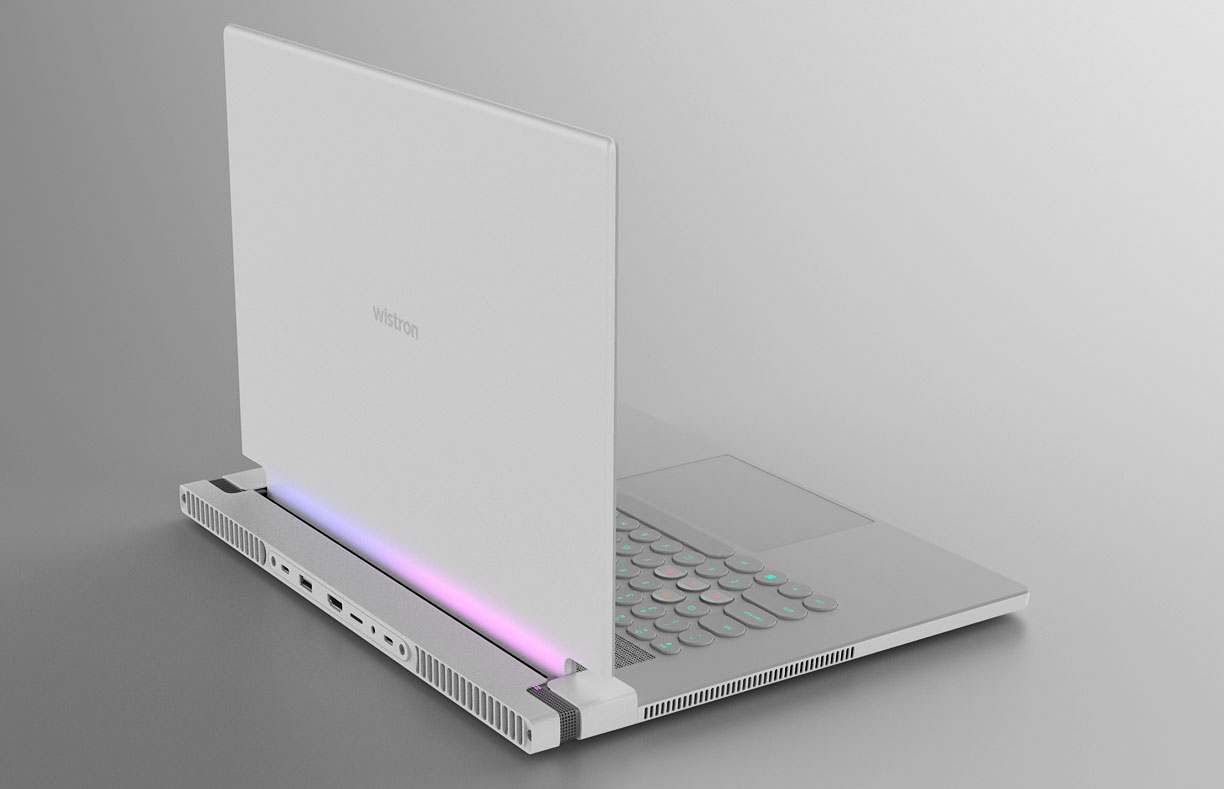New dynamic airflow concept aims to boost gaming laptop cooling with displaced external heat module — Laptop ODM Wistron's 'Hinge Auto-Extension' wins design award
An interlocking mechanism activated by opening the laptop extends the heat module for an airflow boost.

One of the world's biggest laptop ODMs has won an iF Design Award for its innovative laptop cooling enhancement technology, reports Liliputing. Taiwan's Wistron has revealed its new Dynamic Airflow system, based on the concept of a 'Hinge Auto-Extension,' in a series of laptop renders. The images show that when a user opens up a clamshell laptop the rear 'shelf' heat module gets extended to boost airflow.
Wistron's iF Design Award product description text is fairly brief. It presents the cooling problem in a typical laptop design where the motherboard and thermal component overlap. The solution it has come up with takes them out of alignment as the laptop is opened, and allows for much greater airflow.
People seem naturally attracted to thin and light laptops for portability but this creates a difficult thermal engineering problem, especially with workstations and gaming laptops packing GPUs which can consume over 100W alone in heavy workloads.
We have seen laptop makers leverage many innovations in recent years to try and keep thermals / noise under control. A recent example that springs to mind is the Asus ROG Zephyrus Duo 16. The second screen tilts upwards 13 degrees for better ergonomics and increased air intake. Less glamorous but also useful screen hinges that lift the bottom of a laptop off a desk when flexed have gained popularity.
If not for the design award win, we might never have seen Wistron associated with its new Hinge Auto-Extension design. As an ODM it doesn't release products under its own name, but familiar brands that have at one time or another made use of Wistron's services include Microsoft, Lenovo, HP, Dell, Acer, and Xiaomi.
Whether one of the brands we know works with Wistron as an ODM picks up this idea as it stands, or adapts it, remains to be seen. With an iF Design Award under its belt, it may be likely that some vendors are now looking closely at the Wistron 'Hinge Auto-Extension'. It might even be under test at one or more laptop makers, as the problem of hot processors in thin laptops is set to remain for some time. Last but not least, if and when this Wistron innovation does become available in a laptop, we'll be sure to grab one for testing and review.
Get Tom's Hardware's best news and in-depth reviews, straight to your inbox.

Mark Tyson is a news editor at Tom's Hardware. He enjoys covering the full breadth of PC tech; from business and semiconductor design to products approaching the edge of reason.
-
Notton So if I'm to understand how this works, when the screen is opened, the mobo, heatsink, and fans are pulled backwards to improve air intake?Reply
Is it like a server rack on sleds that you pull out slightly?
I guess having the keyboard and trackpad slide forward wasn't as good? -
M0rtis ReplyNotton said:So if I'm to understand how this works, when the screen is opened, the mobo, heatsink, and fans are pulled backwards to improve air intake?
Is it like a server rack on sleds that you pull out slightly?
I guess having the keyboard and trackpad slide forward wasn't as good?
To me it looks like the rear bracket/cover just slides outwards when the hinge is activated to uncover the mesh section. I guess it just removes any exhaust bottlenecks vs if the mesh area wasnt available. I dont think any of the computing hardware slides anywhere. At most the IO panel is on a separate board and connected by ribbon cable if the IO is present at the back. -
dmitche31958 Reply
I agree. Moving connections doesn't sound like a plan for success. Nobody would disagree that this would be another point of failure. Enough said.M0rtis said:To me it looks like the rear bracket/cover just slides outwards when the hinge is activated to uncover the mesh section. I guess it just removes any exhaust bottlenecks vs if the mesh area wasnt available. I dont think any of the computing hardware slides anywhere. At most the IO panel is on a separate board and connected by ribbon cable if the IO is present at the back. -
Notton Reply
Okay, but if that were true why is there a total lack of ports on the side?M0rtis said:To me it looks like the rear bracket/cover just slides outwards when the hinge is activated to uncover the mesh section. I guess it just removes any exhaust bottlenecks vs if the mesh area wasnt available. I dont think any of the computing hardware slides anywhere. At most the IO panel is on a separate board and connected by ribbon cable if the IO is present at the back.
All the ports are on the back, and the rear section slides out. So this means either the mobo tray moves with those rear ports, or those ports use a cable that has to flex often. The power connector is sitting on the back, and that's usually not a flexible internal cable for laptops, if it were connected to a daughter board.
If the ports slide out, why would this be enough to win an innovative design award? -
nameless0ne From what I've gathered from the article - the only thing they've actually designed is the hinge. They call the extended part the "heat module". Some gaming laptops have their heatsinks in that place. But it is likely that did not design the actual "heat module." The article states that only renders were provided.Reply
So all of this is just like a concept car without an engine and drive train. Just an idea that requires a lot of additional work to implement.
And as some have mentioned - more moving parts = more points of failure. This will likely never come to fruition.

